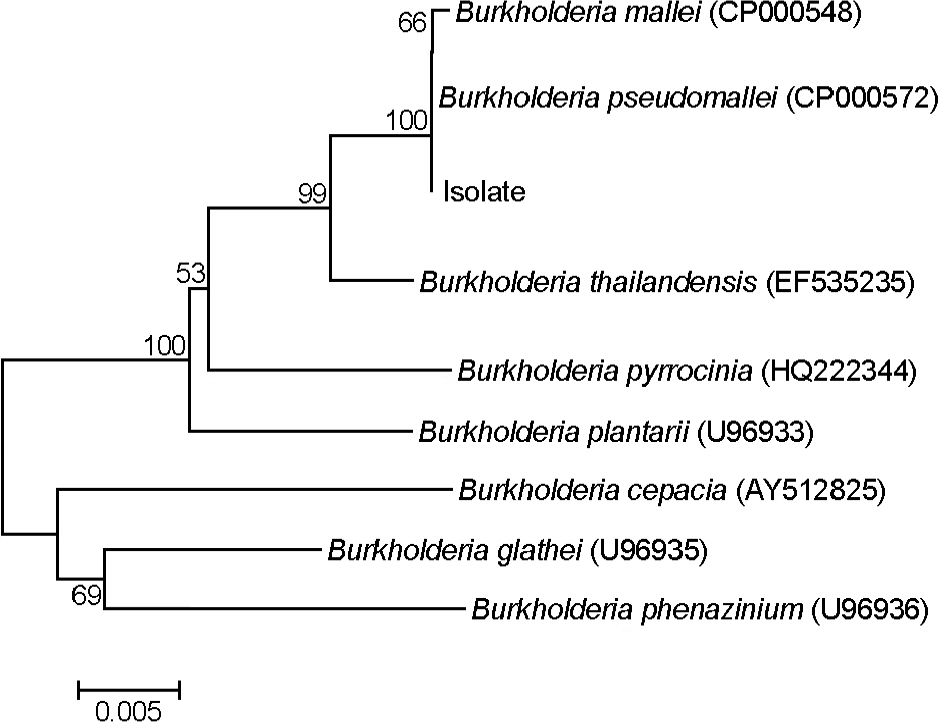J Bacteriol Virol.
2011 Mar;41(1):19-25. 10.4167/jbv.2011.41.1.19.
The Laboratory Diagnosis of Melioidosis in a Korean Patient
- Affiliations
-
- 1Division of High-risk Pathogen Research, Center for Infectious Diseases, National Institute of Health, Osong Health Technology Administration Complex, Cheongwon, Korea. ckyoo@nih.go.kr
- 2Division of Non-Vascular Plants, National Institute of Biological Resources, Korea Environmental Research Complex, Incheon, Korea.
- KMID: 1449859
- DOI: http://doi.org/10.4167/jbv.2011.41.1.19
Abstract
- Burkholderia pseudomallei is a gram-negative opportunistic intracellular pathogen that causes an acute and fatal septicemic melioidosis in humans. The organism is mainly found in Southeastern Asia and Northern Australia. Recently, we encountered a case of melioidosis in a Korean patient and performed the laboratory diagnosis of melioidosis. As a result, a gram negative bacterium was isolated from a melioidosis patient, and it was identified as B. pseudomallei on DNA sequencing of 16S ribosomal RNA with 99.9% homology and biochemical examination of VITEK gram-negative identification card. Also, DNA from cultured bacteria was tested in multiplex PCR, a 245 bp fragment amplified from the metalloprotease gene and a fragment of variable size ranging from 400~700 bp resulting from amplification of the 10 bp repetitive element for B. pseudomallei were confirmed after electrophoresis. The bacterium was sensitive to ceftazidime, imipenem and meropenem but resistant to ticarcillin. So far, there are no domestic cases of melioidosis in Korea, however, due to the increase in international travelers, the incidence of melioidosis is likely to increase. We report a recent case of melioidosis in a Korean patient.
Keyword
MeSH Terms
-
Asia, Southeastern
Australia
Bacteria
Burkholderia pseudomallei
Ceftazidime
Clinical Laboratory Techniques
DNA
Electrophoresis
Humans
Imipenem
Incidence
Korea
Melioidosis
Multiplex Polymerase Chain Reaction
RNA, Ribosomal, 16S
Sequence Analysis, DNA
Thienamycins
Ticarcillin
Ceftazidime
DNA
Imipenem
RNA, Ribosomal, 16S
Thienamycins
Ticarcillin
Figure
Reference
-
1). Currie BJ., Dance DA., Cheng AC. The global distribution of Burkholderia pseudomallei and melioidosis: an update. Trans R Soc Trop Med Hyg. 2008. 102:S1–4.2). Cheng AC., Currie BJ. Melioidosis: epidemiology, patho-physiology, and management. Clin Microbiol Rev. 2005. 18:383–416.
Article3). Seok HJ., Kim JI., Lee JH., Choo EJ., Kwak YG., Jang S, et al. A case of septic pneumonia due to Burkholderia pseudomallei. Infect Chemother. 2004. 36:114–7.4). Lee SW., Yi J., Joo SI., Kang YA., Yoon YS., Yim JJ, et al. A case of melioidosis presenting as migrating pulmonary infiltration: the first case in Korea. J Korean Med Sci. 2005. 20:139–42.
Article5). Son JY., Kwon KT., Choi EJ., Park JP., Song YD., Lee JC, et al. Fatal melioidosis in a tourist returning from Cambodia. Korean J Med. 2009. 77:246–50.6). Lee HM., Choi SH., Chung JW., Ahn J., Cho AR., Lee MK, et al. A case of disseminated melioidosis in a migrant worker from Thailand. Korean J Lab Med. 2009. 29:140–4.
Article7). Current status and laboratory diagnosis of melioidosis, Korea Centers for Disease Control and Prevention. Public Health Wkly Rep. 2010. 3:276–9.8). Ashdown LR. Identification of Pseudomonas pseudomallei in the clinical laboratory. J Clin Pathol. 1979. 32:500–4.9). Lee MA., Wang D., Yap EH. Detection and differentiation of Burkholderia pseudomallei, Burkholderia mallei and Burkholderia thailandensis by multiplex PCR. FEMS Immunol Med Microbiol. 2005. 43:413–7.10). Epidemiologic investigation for a melioidosis mortality case, Korea Centers for Disease Control and Prevention. Public Health Wkly Rep. 2010. 3:180.11). Gan YH. Interaction between Burkholderia pseudomallei and the host immune response: sleeping with the enemy? J Infect Dis. 2005. 192:1845–50.
- Full Text Links
- Actions
-
Cited
- CITED
-
- Close
- Share
- Similar articles
-
- Clinical and Imaging Findings of Musculoskeletal Melioidosis in the Right Hip: A Case Report
- Epidemiological Aspects of Imported Melioidosis in Korea and Japan, 2011 to 2020
- A Case of Disseminated Melioidosis in a Migrant Worker from Thailand
- Imported Melioidosis in South Korea: A Case Series with a Literature Review
- Fatal melioidosis in a tourist returning from Cambodia





